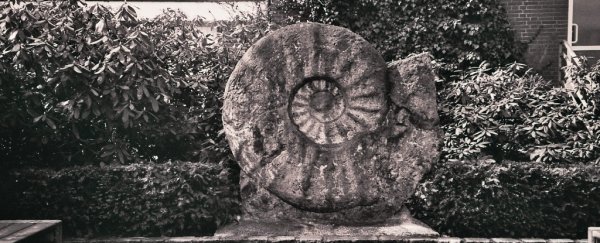During the late Cretaceous, around 80 million years ago, monsters roamed the Earth.
Not just the tyrannosaurs and titanosaurs. Even smaller animals could be super-sized. It was during this time that the size of a type of marine mollusk peaked, with the largest species of ammonite reaching sizes up to 2.5 meters (8.2 feet) across.
No other ammonite ever reached such a prodigious size – and, as with all outliers, scientists have been keen to understand exactly why.
Now, after studying the fossilized remains of 154 ammonites across a range of sizes, an international team led by paleontologist Christina Ifrim of Heidelberg University in Germany think they might have a possible answer: to avoid being eaten by fearsome aquatic mosasaurs.
Evolutionary pressure is a fascinating phenomenon. It occurs when stress is placed on a population in a way that could affect reproductive success. Those individuals with traits best suited to surviving that stress are more likely to reproduce and pass those traits on to offspring.
Microbes that have developed antibiotic resistance are one example of evolutionary pressure.
Predation is a major driver of evolutionary pressure. But there are others; disease, for instance; climate and food availability can also play significant roles. And it can be tricky to work out which of these may have played a role in a species' evolution if information is scarce.
For the giant ammonite Parapuzosia seppenradensis, information has been pretty scarce. It's been difficult to perform comparisons with other ammonites of the Parapuzosia genus, because the fossil record is sparse.
In their new paper, Ifrim and her colleagues studied all available specimens of Parapuzosia leptophylla and P. seppenradensis, including historical fossils, and an abundance of new fossils from Mexico and England.
That's 11 specimens of the much rarer P. leptophylla and 142 specimens of P. seppenradensis. In size, the 154 specimens ranged from 0.1 meters to 1.8 meters, allowing the most complete study yet of the full development cycle of P. seppenradensis.
Based on their study of these animals, the team concluded that P. seppenradensis evolved from P. leptophylla, after the latter had spread from a small and limited habitat off the coastlines of western Europe down to the western Gulf of Mexico.
Just over 80 million years ago, P. seppenradensis differentiated from its ancestor, developing into an animal that could grow much larger in size. The largest P. leptophylla was just 0.7 meters across – still large, but nothing like the gargantuan sizes of its descendant.
It's impossible to make a conclusive ruling on why the creatures grew so large, but the team was able to hazard a guess. Although there were some climate shifts that may have played a role, these are insufficient to explain the entire shift in size.
However, at the same time as the ammonites were increasing in size, so too was another creature: the aquatic reptile genus Mosasaurus. These fierce beasties, top predators of the Cretaceous seas, were known to prey on ammonoids, and their rapid growth during the Late Cretaceous closely paralleled the growth of P. seppenradensis.
It makes sense; if you can't get your mouth around a shell, it's harder to eat the delicious mollusk inside.
It's not a perfect answer; while mosasaurs continued to grow, after a time, P. seppenradensis started to shrink in size, which, the researchers said, clearly has nothing to do with mosasaurs. Further analysis may be necessary to work out how closely interlinked the two species may have been.
But it does seem to be the best fit, based on currently available information.
"No other short-term global environmental trend is presently identified that correlates with the increase in size of this ammonite across the Santonian-Campanian boundary," the researchers write.
The research has been published in PLOS ONE.
